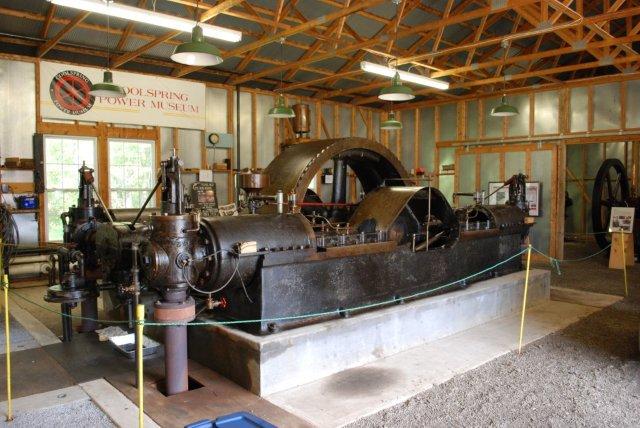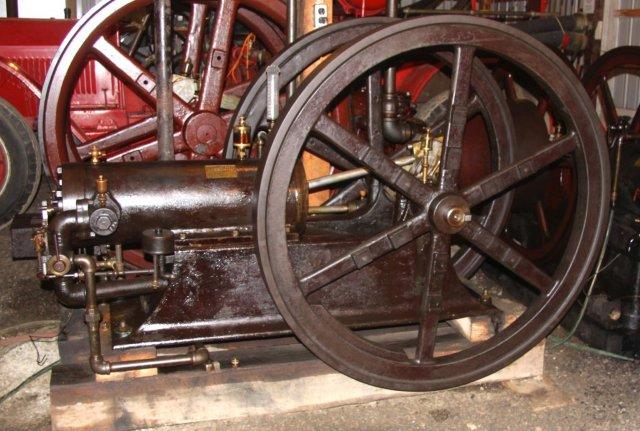
May 2012
The Engines of Ohio
By Paul Harvey
As this is being written, the weather has become unseasonably warm and pleasant which means activity at the Coolspring Power Museum. Already our underground piping system for fuel, air and water has been extended and improved which should make the engineers job easier now. Our two new buildings erected last year have the pipe work installed and now the wiring is being done. During the next few months display engines will be moved in and readied for operation. And, of course, progress continues with the 600 hp Snow Engine with the big exhaust pipe and air intake pipe installed. It has turned over on compressed air and all appeared in order so we finally see the end in sight when it will be an operating display. We are also working toward our big June Show where we will feature engines built in the state of Ohio. And so that becomes the topic of this issue.
Ohio has long been known to collectors as "The Engine Capital of the United States" for the great number of manufacturers as well as the wide variety and high quality of the products. A list of makers is being compiled and already we have identified at least 60 different engines. The completed list will be posted on the grounds during the show.
The Northeastern part of the state was noted for its heavy industry which included the Cleveland and Youngstown areas. Probably most prominent was the huge Tod engine made in Youngstown. These equaled the size of our Snow and were used extensively in the steel mills. One Tod steam engine survives. A few other smaller engines were also built in that area. In contrast, the Southeastern part of the state becomes very rugged in terrain and contains many old oil fields. Best known there was the Pattin Bros. of Marietta and the museum has several fine examples. These were somewhat crude and heavy being designed for extended running pumping the then plentiful crude oil. Laughlin Bros. of Woodsfield made a typical and successful "halfbreed" engine which used a gas cylinder converted onto a steam engine frame.
The center of the state is Columbus, the capital city. The Columbus engine was a high quality engine used in industrial settings. They were made in a wide variety of sizes and several examples are displayed here. The vertical Reeves began in Columbus and then later moved to Mt. Vernon. Two fine twin-cylinder Reeves engines operate here. The area bordering Lake Erie had many industrial cities and several built engines. Perhaps the most unusual is the Elyria built in the city of that name. An operating example is displayed here and it must be seen to be appreciated. They built a wide variety of engines but were short lived probably due to their complexity.
The Northwestern part of the state focuses on Toledo and the S. M. Jones company. This area was very flat and level but also oil field and Jones started making engines and equipment to be used there. The company prospered and later made large vertical engines for industrial and pumping use. The Lima area was home to the Lima, Swan, and Buckeye, all unusual engines. However, the true engine capital was Southwestern Ohio centered in the cities of Cincinnati, Dayton, Middletown and Springfield. These engines were all beautifully finished and very complex and offered to a wide market that found homes all across the country. Used in agriculture as well as industry, they all carried the theme of fine workmanship and attention to detail with ornately finished parts making them very handsome to behold.
A few examples include Foos of Springfield, whose 125th Anniversary is being celebrated at our show. Other outstanding examples include the Watkins, Dayton, Callahan, Hamilton, Miami, New Era and Springfield. There are others! These all are well designed engines with much bright finish work. Some are side shaft and others are push rod but all carry the same theme of excellence. Finally there is the Miller made in Springfield which is perhaps the most outstanding to me. They were built in sizes from 35 hp to 400 hp and the museum is proud to have a 50 hp, an 80 hp and the 300 hp that all display their unusual design. They can be seen in operation in the Lillibridge Station. It is hard to imagine how such a small area could produce so many varied but fine engines.
Our photo section includes ten engines built in Ohio from the Coolspring collection. These were chosen to represent a cross section of the many designs built there. The first engine shown, Photo 1, is a very early 10 hp Foos built in Springfield and appropriate for the 125th Anniversary of the company. This engine is serial number 16 and was made in 1893. It was used in a wood working shop on a big estate in Pasadena, California. This is the earliest Foos known in existence. There is no explanation of how their 16th engine was sent to California. Photo 2 shows a 15 hp Ohio built in Sandusky by the Ohio Machine Company. Its wide wheels and throttling governor indicate that it was used to drive a generator for electric lighting service. These two engines can be seen in the Susong Building at the museum.
Photo 3 is the museum's 300 hp Miller Improved made in Springfield in 1913. It is a four-cylinder engine in an "H" configuration and uses the Watts balanced exhaust valves and governor. Installed in the Spring Creek station near Kane, PA, it operated an air compressor to pump oil wells until removed in 1976 when it came here. It runs for the visitors during our shows and is located in the Lillibridge Station. This massive machine weighs 35 tons! Photo 4 is the 25 hp Pattin Bros built in Marietta about 1915. It is shown when it was still at the Wilcox collection in Ohio. This engine operated oil wells in southeastern Ohio and now runs at a temporary outside location.
Photo 5 is the 20 hp "old style" St. Marys built in St. Marys, Ohio. It pumped an oil lease near Duhring, PA. St. Marys built a wide variety of engines and this is one of the earliest. Photo 6 shows a small S.M. Jones engine and compressor combination. These units were used to make compressed air to start a large engine and most unique of this one is that it has no crank shaft but used locomotive type side rods to the flywheels. It was used to start a 70 hp Bessemer near Kane, PA. Both these engines can be seen in the Founder's Engine House.
The seventh engine, shown in Photo 7, is an unusual single flywheel Callahan made in Dayton. Using hit and miss governing, this engine actually stops the side shaft from turning during the idle strokes. It pumped an oil well near East Brady, PA. Most remarkable, it went through a fire and has had extensive restoration to operate again. Its design is so typical of those built in southwestern Ohio with attention to appearance and unique mechanism. It can be seen run in the Expo Building.
Engine number 8 is a Watkins made in Cincinnati, Photo 8. It displays the magnificent workmanship of the engines in that area. Watkins was one of the very earliest engines to use throttling governing and integral magneto. It is 8 hp and built in 1898. It was used in a print shop in Northern Vermont where it drove the printing press, then later used in a small sawmill. It was saved in 1970. The ninth engine is a model B Springfield. A 10 hp engine, it was built in Springfield in 1900. It was used to pump water into a cranberry bog on Cape Cod. Both these engines can be seen in the Power House at the museum.
The last engine is the 40 hp Foos, Photo 9, built in 1909 at Springfield. Celebrating the 125th Anniversary of Foos, it is appropriate that we begin and conclude the photos with a Foos. This engine, along with its twin sister, drove Smith Vaile pumps to supply water for the town of Lewisburg, Ohio. It still has original paint and displays all the fine workmanship and detail of engines from this area. This engine was perhaps the favorite of the late Dr. John Wilcox and still operates where he originally installed it. It can be seen in operation in the Power House.
It has been difficult to choose only ten of the
many fine Ohio built engines at the museum, but it is hoped that the
reader enjoys this brief tour.
To see all the rest, as well as the entire
museum, please attend
one of our events.
Our next
open weekend will be May 19 and 20, and the big Exposition and Flea
Market will be June 14, 15, and 16.
There will be many Ohio built engines displayed as well as many
other engines.
We also have
a flea market and good food featuring our gas engine frozen, home made
ice cream.
Looking ahead to
July, we will have a History Day on July 21.
Tours will be given by guides and much equipment will operate.
We encourage all antique cars and trucks to attend and help with
the display.
Watch for more
information about this event!
For more information, please call 814-849-6883.

Photo 1: Early 10 hp Foos engine


Photo 3: 300 hp Miller Improved engine

Photo 4: 25 hp Pattin Brothers engine

Photo 5: 20 hp "old style" St. Marys engine

Photo 6: S.M. Jones engine and compressor

Photo 7: Single flywheel Callahan engine

Photo 8: 8 hp Watkins engine

Photo 9: 10 hp Model B Springfield engine

Photo 10: 40 hp Foos engine